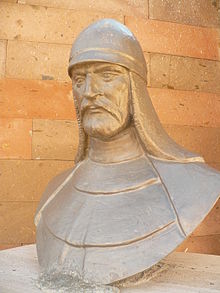Alptigin
| Alp-Tegin | |
|---|---|

Bust of Alp Tegin as one of the founders of the "16 Great Turkic Empires", part of the "Turkishness Monument" (Türklük Anıtı) in Pınarbaşı, Kayseri (opened 2000, 2012 photograph).
|
|
| Governor of Ghazna | |
|
In office 962–963 |
|
| Monarch | Mansur I |
| Succeeded by | Abu Ishaq Ibrahim |
| Personal details | |
| Died | September 963 Ghazna |
Alp-Tegin, (Persian: الپتگین Alptegīn or Alptigīn) was a Turkic slave commander of the Samanid Empire, who would later become the semi-independent governor of Ghazna from 962 until his death in 963.
Before becoming governor of Ghazni, Alp-Tegin was the commander-in-chief (sipahsalar) of the Samanid army in Khorasan. In a political fallout over succession of the Samanids he crossed the Hindu Kush mountains southward and captured Ghazna, located strategically between Kabul and Kandahar in present-day Afghanistan, and thereby establishing his own principality, which, however, was still under Samanid authority. He was succeeded by his son, Abu Ishaq Ibrahim.
Alp-Tegin was originally part of the nomadic Turks that roamed the Central Asian steppes, but was later captured and brought as a slave to the Samanid capital of Bukhara, where he was raised in the Samanid court. Despite being of Turkic stock and allegedly in speech, Alp-Tegin was highly Persianized.
During the reign of Nuh I (r. 943–954), Alp-Tegin was appointed as the head of the royal guard (hajib al-hujjab). During the reign of Nuh's son and successor Abd al-Malik I (r. 954-961), Alp-Tegin was appointed as the governor of Balkh, and by 961 he was the commander-in-chief (sipahsalar) of the Samanid army in Khorasan, thus succeeding Abu Mansur Muhammad. On 10 February 961, Alp-Tegin arrived to Nishapur with his vizier Abu Abdallah Muhammad ibn al-Shibli. Alp-Tegin also played a major role in the appointment of Muhammad Bal'ami as vizier, whom he became close allies with.
...
Wikipedia
